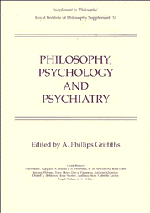Book contents
- Frontmatter
- Contents
- Preface
- Introduction: Just Getting Started
- Mind and Madness: New Directions in the Philosophy of Psychiatry
- Emotion and Memory: The Second Cognitive Revolution
- Meaning and Mechanism in Psychotherapy and General Psychiatry
- Making Sense on the Boundaries: On Moving Between Philosophy and Psychotherapy
- Mental Disorder, Illness and Biological Disfunction
- Integrity, Boundary and the Ecology of Personal Processes
- Multiple Personality and Computational Models
- Psychology and Politics: Lies, Damned Lies and Self-Deception
- Personal Identity and Psychiatric Illness
- Vices and the Self
- Wild Beasts and Idle Humours: Legal Insanity and the Finding of Fault
- Dangerousness and Mental Disorder
- Problems with the Doctrine of Consent
- Homosexuality
- Nietzsche and Music
- References
- Notes on Contributors
Dangerousness and Mental Disorder
Published online by Cambridge University Press: 03 May 2011
- Frontmatter
- Contents
- Preface
- Introduction: Just Getting Started
- Mind and Madness: New Directions in the Philosophy of Psychiatry
- Emotion and Memory: The Second Cognitive Revolution
- Meaning and Mechanism in Psychotherapy and General Psychiatry
- Making Sense on the Boundaries: On Moving Between Philosophy and Psychotherapy
- Mental Disorder, Illness and Biological Disfunction
- Integrity, Boundary and the Ecology of Personal Processes
- Multiple Personality and Computational Models
- Psychology and Politics: Lies, Damned Lies and Self-Deception
- Personal Identity and Psychiatric Illness
- Vices and the Self
- Wild Beasts and Idle Humours: Legal Insanity and the Finding of Fault
- Dangerousness and Mental Disorder
- Problems with the Doctrine of Consent
- Homosexuality
- Nietzsche and Music
- References
- Notes on Contributors
Summary
Unlike topics such as criminal responsibility, dangerousness has only recently begun to interest philosophically minded penologists. The most likely explanation is that until the middle of this century the periods for which people who had done serious harm to others were incarcerated in the UK so long that when they were released their age or condition or circumstances made them unlikely to repeat their crimes. It was only when pressure of resources—in plain terms overcrowded prisons and mental hospitals—forced the shortening of these periods that it became politically necessary to worry about the possible dangerousness of really substantial numbers of prisoners and patients who became eligible for release. The problem was not entirely new. A few lifers, for example, had been set free each year, under licences which lasted for the rest of their lives; and the Special Hospitals which housed the violent insane had discharged carefully selected inmates, also under supervision. But by the late 1960s the introduction of parole, the Mental Health Act and the abolition of capital punishment had greatly increased the number of cases in which the problem of dangerousness had to be faced, and difficult decisions had to be taken.
The United States had had to recognise the problem much earlier, because parole had been an earlier development in their penitentiary systems. Their mental hospitals were slower to recognise it; but in the late 1960s the famous Baxstrom case awakened them to it.
- Type
- Chapter
- Information
- Philosophy, Psychology and Psychiatry , pp. 179 - 190Publisher: Cambridge University PressPrint publication year: 1995
- 3
- Cited by



